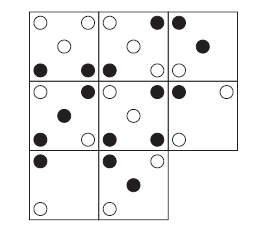Dot Dot Dot and Many Dots.
Algebra
Level
2

Which is the missing square ? Assume that "blank" added to anything else results in a "blank".
B
E
G
A
F
H
C
D
This section requires Javascript.
You are seeing this because something didn't load right. We suggest you, (a) try
refreshing the page, (b) enabling javascript if it is disabled on your browser and,
finally, (c)
loading the
non-javascript version of this page
. We're sorry about the hassle.
On each row, the first two tiles are operands and last tile is the result. The result is calculated in the following manner: Each dot in first operand is combined with a dot in the same location in the second operand. The resulting dot is placed in the same location in the result tile. Combination results are as follows, operations are commutative (operands order doesn't matter):
Hence the correct answer is G (White dot in top left position and black dot in bottom left position).